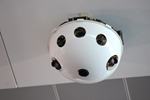With summer travel season hard upon us, specialists at the National Institute of Standards and Technology (NIST) have helped create two new standards designed to increase safety as we rush from gate to gate in crowded mass transit centers. Their efforts will help to fortify against potential bomb threats in the nation's transportation centers.
North Carolina will be the national model for a new system to detect the earliest signs of an impending bioterrorism attack and provide warnings in time to minimize damage to human and animal life as well as the environment.
On Wednesday the Electronic Security Expo (ESX) awarded its Maximum Impact Award Recipients on its largest exhibit show floor ever.
ADT Security Services recently announced that it has completed work on new digital networks allowing the two major international airports serving the Washington, D.C. area to migrate to the latest generation of video surveillance cameras.

A new video surveillance system currently being developed by the Department of Homeland Security’s Science and Technology Directorate (S&T) may soon give law enforcement an extra set of eyes. The Imaging System for Immersive Surveillance (or ISIS) takes new video camera and image-stitching technology and bolts it to a ceiling, mounts it on a roof, or fastens it to a truck-mounted telescoping mast.
In March, the Transportation Security Administration began deploying 150 backscatter imaging technology units, which were purchased with American Recovery and Reinvestment Act funds, in airports across the country. By the end of the year, TSA plans to deploy about 450 of the imaging technology units.
- By Megan Weadock
- Jun 01, 2010
Pivot3 Inc. recently announced the City of Rochester, N.Y., has deployed Pivot3 Serverless Computing as part of its citywide surveillance system that includes more than 100 cameras.
The Department of Homeland Security has updated its Chemical Security Assessment Tool's online FAQ page, which allows visitors to submit CFATS-related questions.
Proxim Wireless Corp., a provider of complete indoor and outdoor wireless broadband ecosystems, recently announced that the City of Vancouver, along with ADT Advanced Integration/Intercon Security and MDT Technical Services, deployed a Proxim wireless network to extend video surveillance throughout the city during the 2010 Winter Olympics and Paralympics.
Avigilon, provider of high definition and megapixel video surveillance systems, announced that one of its customers, Love Field Airport in Dallas, is being showcased today to a delegation of airport executives from Latin America.
The National Insurance Crime Bureau reported recently that 2009 marked the nation's sixth consecutive year of declining vehicle thefts in the United States.

The Finnish Transport Agency for Rail, Maritime and Road Administration, has announced that the pilot project for evaluating an advanced IP-based surveillance system for 11 train stations, was awarded to IndigoVision’s authorized Finnish partner, Taitotekniikka (Kauppahuone Taito Oy).
North American Video announced recently it has been awarded the contract to upgrade the video surveillance system at the New Jersey Performing Arts Center.

Department of Homeland Security Secretary Janet Napolitano has halted funding for the Secure Border Initiative-Net, a system of towers, cameras, radar and sensors initially hailed as "the most comprehensive effort in the nation's history" to assist northern and southern border agents with curtailing illegal immigration.
- By Sherleen Mahoney
- May 01, 2010
DVTel Inc. recently announced that the DVTel intelligent Security Operations Center (iSOC) has been deployed in four Indian cities -- New Delhi, Dehradun, Kashipur and Rudrapur. Optimum Tech Solutions Pvt Ltd. served as the security integrator of record for the projects in Dehradun, Kashipur and Rudrapur and has been instrumental in growing the project in these cities.
The events of Sept. 11 heightened the federal government’s attention to security procedures at chemical/petrochemical facilities and required officials at LyondellBasell to take a fresh look at methods used to secure their facilities.
For anyone who has spent a significant amount of time in an urban setting, the scene of a bomb squad responding to a report of a suspicious package might be all too familiar. But just how is it determined that the lunchbox left under the park bench is just leftovers -- or a lethal weapon? The most common way is spectroscopy.
Verint Systems Inc. today announced that the Metropolitan Council in Minneapolis/St. Paul is implementing the Nextiva Transit video solution from Verint Video Intelligence Solutions.
Department of Homeland Security (DHS) Secretary Janet Napolitano recently announced two enhancements to federal facility security -- initiatives that further strengthen the Department’s ability to protect thousands of government buildings across the United States one week prior to the anniversary of the Oklahoma City bombing.
The Chemical Facility Anti-Terrorism Standards are complex and fairly disruptive. Few would argue that. The risk-based performance standards guidance alone is nearly 200 pages long, and many companies have had to re-allocate or hire staff, facilitate training and certification, and contemplate ways to re-imagine corporate processes in order to control access to chemicals of interest.
- By Marleah Blades
- Apr 13, 2010